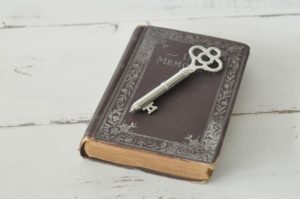Write - to right yourself.
Writing helps heal. Research shows this to be true. I’ve listed below a few great ways to get started with writing – ones which can be especially helpful for survivors. Find a format that works best for you – whether that’s pen on paper, or typing on a keyboard. You could try an online journal like Penzu, or if you want to be prompted to write, try ohLife.com, which will send you “friendly emails asking ‘How’d your day go?’” – and all you have to do is respond to the emails to create your online journal.
Journal
Journaling was mentioned in Key 2, because it can be an excellent way to center yourself. Dr. James Pennebaker, author of Writing to Heal, suggests 4 days, 20 minutes a day of undisturbed uncensored writing. I like to call this approach to journaling “verbal diarrhea” – because the idea is to just release what’s pent up. At its best, journaling can help us organize our thoughts, make sense of our experiences, and sort out where to go from here.
Put words to your story
If we can describe a difficult experience in words, then the experience itself becomes more manageable, and we can fit it in to our life story. What’s the value to fitting something into our life story? Neuroscientist Dan Siegel tells us that this can help with brain integration. The more integrated we are, the better. Being able to put our childhood experiences into words is an important practice that can help heal old wounds.
Connect the dots
Writing can be helpful in ‘connecting the dots’ of what happened. Traumatic memories can be incomplete. What do you know about what happened? What pieces are fuzzy to you? What parts do other people who knew you in the past remember? Stay within your comfort zone when asking other people.
Track Your Progress
Perhaps most importantly, writing is an excellent way to recognize and track your progress. Give yourself credit for the work that you’re doing, and periodically congratulate yourself on how far you’ve come. Acknowledge and celebrate your successes. There will be times when you feel discouraged and frustrated by the fact that despite all the work you’ve done, you still aren’t through. During these times, there is no better safety net than your own written descriptions of your successes and your progress. Flag these in your journal so they’re easy to return to.
Inner Children
In Key 1, we talked about our “parts.” Survivors often have one or more parts that never grew up. Some people call these parts “inner children.” It can be really helpful to acknowledge our child parts in writing and let them express themselves. Who are your inner children, and how can you welcome them? Allow your inner child to do some of the story-telling. Buy your inner child a new box of crayons as a gift, and journal in color! Try writing or drawing with your non-dominant hand.
Dream Journal
If you are someone who remembers your dreams, a writing exercise you might like to try is dream journaling. People disagree on whether or not dreams have meaning, but either way, journaling about your dreams is a good exercise in using writing to make sense of your world. Some people believe that nightmares are our brain’s attempts at helping us process traumatic experiences. Some survivors report having had recurrent nightmares. Journal about this only if it feels helpful to you.
Pronoia
Pronoia is the opposite of paranoia. It’s the belief that the universe is conspiring in your favor. In many ways, we may be the last group of people on earth who should feel that the universe is conspiring in our favor- yet in healing, we can choose to see the ways in which we are supported. Holding your healing process in mind, start by asking yourself some “what if” questions. What if, even though this process is painful, it’s a blessing that I’m dealing with this now instead of as a child? What if this is somehow for the best? What if the universe set up that present-day situation precisely to trigger that old feeling in me so I could finally resolve it? What if I’m being supported in ways I can’t even see?
Depending on your spiritual beliefs, you may prefer to do this exercise with your faith in mind.
Connect with your future self
If your present day self can have a relationship with your inner children, then why not also have a relationship with your future self? Your future self is the best of all that you can imagine. Describe what this future self is like. Imagine how it feels to be fully known, fully seen, and fully loved by this beautiful being, whose seed resides in your heart right now.
Metacognition
Metacognition means thinking about our thinking. Why is this important? Because, simply put, childhood abuse leads to thinking that is faulty because it sits on a bad foundation. Recovery involves making changes to your mental connections that make up this foundation. Thanks to neuroplasticity, we can change even longstanding patterns. What beliefs do I hold that are no longer serving me? In what ways does my thinking limit my possibilities in life? Do I have habits I’d like to change?
Soak in the Good
Rick Hanson has a wonderful practice for counteracting our brain’s negativity bias. He advises us to spend some time focusing on the good things, however small. Don’t “waste” your mild good experiences. Take some time to write about the good in your day – even simple experiences lik eating something yummy, petting a cat, or hugging a friend.
Name the Hole
What do you feel is missing in your life? Try naming the hole, describing it in detail, including what emotions you feel around it, where you think it came from, and what it would take to fill it. What could you change to make filling it be possible?

